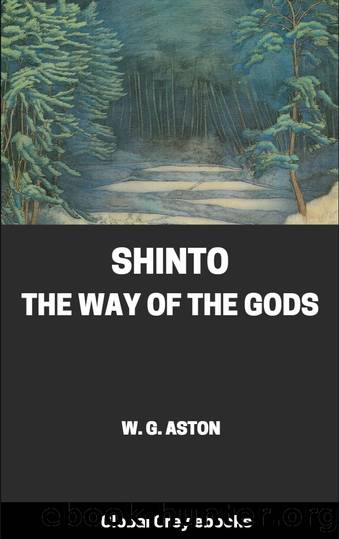Shinto, the Way of the Gods by W. G. Aston

Author:W. G. Aston [Aston, W. G.]
Language: eng
Format: epub
Tags: Shinto, Japan
Publisher: Global Grey ebooks
Published: 2020-09-28T23:00:00+00:00
* * *
Chapter 9. The Priesthood
Shinto illustrates the principle enunciated by Herbert Spencer, that "in early stages of social evolution the secular and the sacred are but little distinguished." The Mikado was at the same time high priest and king. There was no well-marked distinction between secular and religious ceremonies. The functionaries who performed the latter had no specially sacerdotal character and no distinctive costume. The Jingikwan, or Department of Religion, was simply a Government bureau, and the rites celebrated in its chapel were as much Government proceedings as the issuing of decrees or the collection of taxes. Almost any official might be called upon to discharge religious functions. The local governors on their appointment made a round of visits for worship to all the shrines in their jurisdiction. All the principal shrines had State endowments. The word matsuri-goto, government, is simply matsuri, a religious festival, with the termination koto, thing, which adds nothing to its etymological significance. Hirata says that the worship of the Gods is the source of Government--nay, it is Government. The same word miya (august-house) was in common use both for shrines and palaces. There was, however, a beginning of a differentiation of sacred and secular functions. The Mikado delegated some of his religious duties to the Nakatomi House, and, as we shall see, other religious duties were hereditary in other families. Thus a Sun-worship Be, or hereditary corporation, was established in 577. One version of the myth of Ohonamochi represents him as giving up his authority with the words, "Let the august grandchild direct the public affairs of which I have charge: I will retire and direct secret matters." Evidently we have here an echo of some actual separation of civil and religious authority. Far on into historical times the guardians of the "Great Shrine" of Ohonamochi in Idzumo retained a title (kuni no miyakko) which, like that of pontifex at Rome, implied the performance of secular duties. In the reign of Kwammu (782-806) it was found that the local nobility (kuni no miyakko), many of whom still acted as governors, neglected their civil functions, on the pretence that their time was occupied by religious duties. A decree was therefore issued that in future no local nobles should hold the office of civil governor.
The Mikado.--The chief priest of Shinto is the Mikado himself. Jimmu, the legendary founder of the dynasty, is represented as performing sacrifice in person. JingÅ is said to have acted on one occasion as kannushi. In historical times Mikados presided personally over the ceremonies of Nihiname, Shinkonjiki, Kanname, and other festivals. Even at the present day the Mikado's priestly functions are not entirely obsolete.
Nakatomi.--For many centuries most of the Mikado's sacerdotal functions have been delegated. In the Jimmu legend there is mention of the appointment of a Michi no Omi (minister of the way) as ruler of a festival in honour of Taka-musubi. At the dawn of history we find the Nakatomi hereditary corporation the recognized vicars of the Mikado. Tradition traces their descent from the God Koyane.
Download
This site does not store any files on its server. We only index and link to content provided by other sites. Please contact the content providers to delete copyright contents if any and email us, we'll remove relevant links or contents immediately.
Never by Ken Follett(2873)
Machine Learning at Scale with H2O by Gregory Keys | David Whiting(2269)
Fairy Tale by Stephen King(2059)
Will by Will Smith(2033)
Fantastic Beasts and Where to Find Them: The Original Screenplay by J. K. Rowling(2032)
The Storyteller by Dave Grohl(1656)
Cloud Cuckoo Land by Anthony Doerr(1428)
The Becoming by Nora Roberts(1324)
Friends, Lovers, and the Big Terrible Thing by Matthew Perry(1324)
New Morning Mercies: A Daily Gospel Devotional by Paul David Tripp(1305)
A Short History of War by Jeremy Black(1295)
HBR's 10 Must Reads 2022 by Harvard Business Review(1251)
Go Tell the Bees That I Am Gone by Diana Gabaldon(1231)
Can't Hurt Me: Master Your Mind and Defy the Odds - Clean Edition by David Goggins(1223)
The Complete Witcher by Andrzej Sapkowski(1219)
Cytonic by Brandon Sanderson(1216)
515945210 by Unknown(1205)
Fear No Evil by James Patterson(1106)
This Family Does It by Kevin Sellers(1079)
